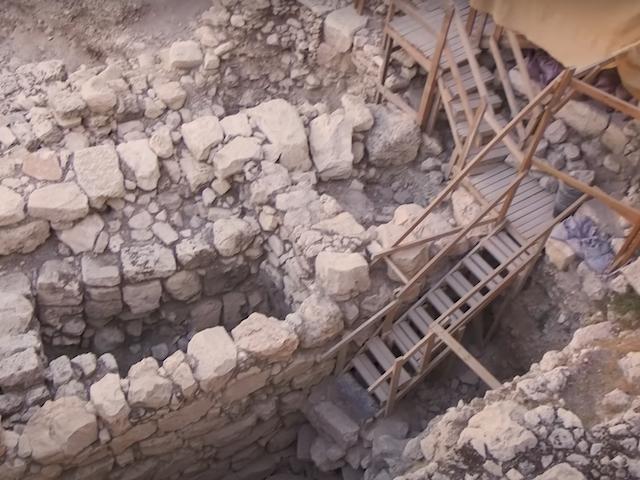Jerusalem, the Eternal City, reveals another secret of its storied past. Following a century and a half of tireless exploration, archaeologists from the Israel Antiquities Authority and Tel Aviv University have unearthed a monumental moat within the City of David, nestled in the heart of the Jerusalem Walls National Park. This awe-inspiring discovery, announced on Sunday, sheds new light on the engineering genius and political might of ancient Jerusalem's rulers.
A Massive Defensive Structure
The colossal trench, measuring an astonishing 70 meters in length, plunging 9 meters deep, and spanning 30 meters wide, likely served as a formidable barrier between the upper city—home to the sacred temple and regal palace—and the bustling lower city. Researchers from the Israel Antiquities Authority and Tel Aviv University assert that this moat was meticulously designed to alter the natural landscape, showcasing the authority and ingenuity of Jerusalem’s ancient leaders to all who dared approach its gates.
Jerusalem/Zion, Israel's capital since the days of King David, 3,000 years ago.
— Avi Nir-Feldklein (@avraham_nir) July 26, 2024
Interesting read today in the Norwegian newspaper Dagen:
"Believes "dramatic" discovery in Jerusalem confirms biblical reference"
"Mentioned in the Bible
The moat is nine meters deep and 30 meters…
Historical Significance
The discovery, made during extensive excavations of the Givati Parking Lot, reveals that the moat functioned as a crucial defensive line, demarcating the City of David from the Temple Mount and Ophel areas. Its sheer, perpendicular cliffs rendered it nearly impassable, a testament to the strategic foresight of its creators. Initially perplexed by its purpose, archaeologists eventually discerned that this structure served as the northern fortification of the lower city, effectively separating residential zones in the south from the acropolis in the north.
Engineering Marvel of the Kingdom of Judah
Excavation directors Yuval Gadot of Tel Aviv University and Yiftah Shalev of the Israel Antiquities Authority have dated the moat to nearly 3,000 years ago, during the reign of King Josiah when Jerusalem was the capital of the Kingdom of Judah. The construction of such an imposing feature underscores the advanced engineering capabilities and the authoritative control exercised by Jerusalem’s rulers.
Archaeologists discover ancient Jerusalem moat, solving 150-year-old mystery https://t.co/fUucwigk2O via @RNS My latest article.
— Michele Chabin (@MicheleChabin1) July 26, 2024
Resolving a Centuries-Old Mystery
Despite numerous attempts over the past 150 years to trace Jerusalem’s northern fortifications, the full extent of these defenses only came to light during recent excavations. Eli Alony, Vice President of the City of David Foundation, hailed the discovery as “the resolution of a long-standing mystery in the City of David.”
Archaeologists, led by Gadot and Shalev, have been meticulously working on the Givati Parking Lot excavation for approximately 15 years. “Typically, when excavating, you assume you’ll eventually reach bedrock, the foundation upon which structures are built. However, we never found the rock. So, we kept digging deeper and deeper and gradually realized we were working within a man-made gorge,” Gadot explained.
Piecing Together the Past
As scientists continued their excavation and reviewed past publications, they realized that previous researchers had also encountered this trench. However, earlier excavations, including those by British archaeologist Kathleen Kenyon in the 1960s, mistakenly identified it as part of a natural valley rather than a defensive moat. Only now, with the full scope uncovered, can archaeologists confidently assert that this trench was engineered to thwart attacks on the ancient city’s vulnerable northern border.
Even 3,000 years ago the #Jewish State faced serious security challenges.
— Amb. Yacov Livne 🇮🇱 (@YacovLivne) July 24, 2024
New archeological findings in #Jerusalem reveal a large moat to defend the ancient ✡️ capital.
Fascinating. pic.twitter.com/fxhEjUqKOX
A Window into a Strong Judaean Kingdom
The discovery not only resolves long-standing questions dating back 150 years but also raises new inquiries regarding the construction methods and exact timeline of this engineering marvel. Researchers have narrowed the moat's construction to between 2,900 and 3,800 years ago, painting a vivid picture of a robust Judaean kingdom a millennium before the common era.
New Questions, New Horizons
Yiftah Shalev from the Israel Antiquities Authority elaborated on the emerging questions and answers surrounding the discovery. “It is not known when the moat was originally cut, but evidence suggests it was used during the centuries when Jerusalem was the capital of the Kingdom of Judah, almost 3,000 years ago, beginning with King Josiah,” Shalev stated.
The archaeological team has found pottery fragments in the area dating back 2,600-2,700 years, further supporting the moat's extensive historical use. The results of this groundbreaking excavation will be presented at the City of David’s Jerusalem Studies Experience Conference in early August, where archaeologists have already published a comprehensive paper on their findings.
Archaeologists have discovered a 3,000-year-old structure that confirms stories found in the Bible. The structure - a nine metre long moat - can be found in the City of David in Jerusalem and is mentioned in two different books of the Bible. pic.twitter.com/D7Lh6ipwSd
— Nirmata (@En_formare) July 23, 2024
A Testament to Ancient Jerusalem's Grandeur
This monumental discovery not only highlights the engineering prowess and strategic acumen of ancient Jerusalem’s rulers but also enriches our understanding of the city’s storied past. As researchers continue to unearth the secrets of the City of David, each new find brings us closer to comprehending the full grandeur of Jerusalem's ancient heritage.


